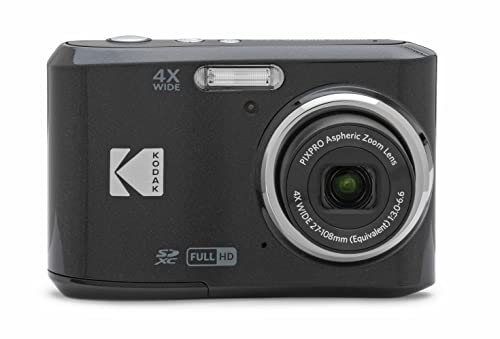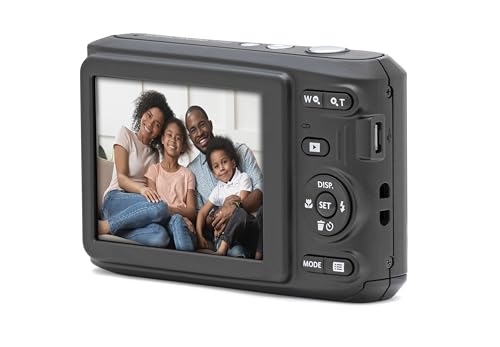

As a photography enthusiast, finding the best ISO setting for your digital camera can greatly enhance the quality of your images. ISO is a crucial element in photography that determines the sensitivity of your camera’s sensor to light. It plays a significant role in creating well-exposed and sharp photographs, especially in low-light conditions.
Choosing the right ISO setting depends on the lighting conditions and the desired effect you want to achieve in your photos. Lower ISO values, such as 100 or 200, are ideal for bright, well-lit environments, as they produce images with minimal noise and maximum sharpness. On the other hand, higher ISO values, like 800 or 1600, are suitable for low-light situations, allowing you to capture more light and details in your shots.
Experimenting with different ISO settings and understanding how they impact your photos is essential for improving your photography skills. By mastering the ISO setting on your digital camera, you can take your images to the next level and create stunning visual masterpieces.
Understanding ISO Setting
When it comes to photography, understanding ISO setting is crucial for achieving the best results. ISO refers to the sensitivity of your camera’s sensor to light. A higher ISO setting makes the sensor more sensitive to light, allowing you to capture images in low-light conditions without a flash.
However, increasing the ISO setting also introduces digital noise or graininess to your photos, which can degrade the image quality. It’s essential to strike a balance between achieving proper exposure and minimizing noise when selecting the ISO setting for your shots.
Key Points to Remember:
- Low ISO: Use a low ISO setting (e.g., 100 or 200) for bright lighting conditions to produce sharp and noise-free images.
- Medium ISO: Opt for a medium ISO setting (e.g., 400-800) for indoor or low-light situations where you need a bit more sensitivity without compromising too much on image quality.
- High ISO: Reserve high ISO settings (e.g., 1600 or higher) for extremely low-light scenarios, but be prepared for increased noise in your photos.
Understanding ISO in Photography
ISO is a key setting in photography that determines the sensitivity of your camera’s sensor to light. It plays a crucial role in capturing images in various lighting conditions, from bright sunlight to low-light settings.
Adjusting the ISO setting on your camera allows you to control the amount of light that reaches the sensor, which in turn affects the exposure and overall quality of your photos. A higher ISO setting makes your camera more sensitive to light, allowing you to shoot in dimly lit environments without using a flash.
When selecting the ISO setting for your digital camera, consider the lighting conditions of your shooting environment and the desired outcome of your photos. Experimenting with different ISO settings will help you understand how it impacts the quality and noise levels in your images.
Importance of ISO Setting
When it comes to photography, the ISO setting on your digital camera plays a crucial role in determining the sensitivity of the sensor to light. Understanding the importance of ISO setting can significantly impact the quality of your photos.
Adjusting the ISO setting allows you to control the amount of light that reaches the sensor, which is essential in various lighting conditions. A higher ISO setting is ideal for low-light situations, as it makes the sensor more sensitive to light, enabling you to capture clear and sharp images without using a flash.
- Low ISO: Results in less noise but requires more light.
- High ISO: Increases noise but allows for better performance in low-light conditions.
Choosing the Best ISO Setting
When it comes to selecting the ideal ISO setting for your digital camera, there are several factors to consider. One of the primary considerations is the lighting conditions in which you will be shooting. If you are in a well-lit environment, a lower ISO setting such as 100 or 200 may be sufficient to capture clear and sharp images without introducing noise.
On the other hand, if you are shooting in low light or dimly lit conditions, you may need to increase the ISO to a higher setting like 800 or 1600 to ensure proper exposure. However, keep in mind that higher ISO settings can introduce digital noise, which can degrade the overall quality of your images.
- Low Light Conditions: Use a higher ISO setting to capture more light and prevent blurry images.
- Well-Lit Environments: Stick to lower ISO settings to maintain image quality and reduce noise.
- Experiment: Don’t be afraid to experiment with different ISO settings to find the optimal balance between exposure and image quality for your specific shooting conditions.
Low ISO Settings
When it comes to ISO settings on a digital camera, opting for a low ISO value can be beneficial in certain situations. Low ISO settings, such as 100 or 200, are ideal when shooting in bright lighting conditions or when you want to achieve high image quality with minimal noise.
By selecting a low ISO setting, you are telling your camera to use less sensitivity to light, resulting in a finer image with less graininess. This is particularly useful for landscape photography, where you want to capture intricate details and vibrant colors without compromising on image quality.
- Low ISO settings are perfect for capturing sharp images in well-lit environments.
- They are ideal for situations where you want to maintain high image quality and minimize noise.
- Using low ISO settings can help you achieve vibrant colors and detailed images, especially in landscape photography.
Mid-range ISO Settings
When it comes to capturing images in various lighting conditions, mid-range ISO settings play a crucial role in achieving the desired results. As a photographer, I often find myself adjusting the ISO to strike a balance between image quality and noise levels.
One effective approach is to set the ISO between 400 and 800 for situations where the lighting is moderate or when you need a bit more sensitivity without introducing too much noise. This range allows for flexibility in capturing details while maintaining a decent level of overall image quality.
- ISO 400: Offers a good compromise between sensitivity and noise, ideal for indoor and outdoor shots with sufficient lighting.
- ISO 800: Provides increased sensitivity for low-light conditions without significant loss of image quality, making it suitable for dusk or dimly lit environments.
High ISO Settings
High ISO settings can be a useful tool in low-light situations or when you need to capture fast-moving subjects. However, it’s important to understand the trade-offs involved, such as increased noise and reduced image quality. Here are some key points to keep in mind when using high ISO settings:
- Increased Noise: As you raise the ISO setting, the camera’s sensitivity to light increases, but so does the amount of digital noise in your images. This can lead to grainy or speckled textures, especially in darker areas of the photo.
- Reduced Dynamic Range: High ISO settings can also limit the camera’s ability to capture a wide range of tones in a single image, leading to loss of detail in highlights and shadows.
- Artistic Effects: Despite the drawbacks, high ISO settings can be used creatively to achieve a certain aesthetic, such as a gritty or high-contrast look. Experiment with different ISO values to see how they affect the mood of your photos.
Conclusion
When it comes to choosing the best ISO setting for your digital camera, it’s essential to consider the lighting conditions, desired image quality, and creative vision for the shot. While high ISO settings can help you capture photos in challenging situations, they also come with trade-offs that may impact the overall look of your images. Experiment with different ISO values and learn how to balance sensitivity and image quality to achieve the best results for your photography.
Best iso setting for digital camera
Features
| Part Number | DC101 |
| Model | DC101 |
| Warranty | 1 |
| Color | Black |
Features
| Part Number | FZ45BK |
| Model | FZ45BK |
| Warranty | Limited 1-Year Warranty |
| Color | Black |
| Release Date | 2022-10-03T00:00:01Z |
| Price history for KODAK PIXPRO 16MP Zoom Digital Camera | |
|---|---|
|
Latest updates:
|
|
Features
| Part Number | DSCHX80/B |
| Model | DSCHX80/B |
| Warranty | |
| Color | Black |
| Release Date | 2016-04-14T00:00:01Z |
Q&A:
What is the best ISO setting for a digital camera?
The best ISO setting for a digital camera depends on the lighting conditions and the desired effect you want to achieve. In general, lower ISO settings (100-400) are recommended for bright light conditions to reduce noise and maintain image quality, while higher ISO settings (800-3200) are better for low light situations to capture more light but may introduce more noise.
How does ISO affect digital camera photos?
ISO affects the sensitivity of the camera’s sensor to light. A higher ISO setting makes the sensor more sensitive, allowing you to shoot in low light conditions or capture fast-moving subjects. However, higher ISO settings can also lead to more noise in the image. It’s important to find a balance between ISO and other settings to achieve the desired result.
Can I manually adjust the ISO setting on my digital camera?
Most digital cameras allow you to manually adjust the ISO setting. By selecting a specific ISO value, you can control the sensitivity of the sensor to light and customize the look of your photos. Experimenting with different ISO settings in various lighting conditions can help you understand how ISO impacts your images and improve your photography skills.























